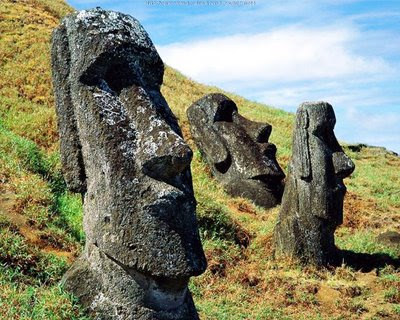Easter Island has long been the subject of curiosity and speculation. How and why did its inhabitants carve and transport the massive statues which surround the island? What remains of this culture today, and what lessons can we learn from their legacy? This page is a resource for information on the Internet about Easter Island, also known as "Rapa Nui" and "Isla de Pascua".
Easter Island is over 2,000 miles from the nearest population center, (Tahiti and Chile), making it one of the most isolated places on Earth. A triangle of volcanic rock in the South Pacific - it is best known for the giant stone monoliths, known as Moai, that dot the coastline. The early settlers called the island "Te Pito O Te Henua" (Navel of The World). Admiral Roggeveen, who came upon the island on Easter Day in 1722, named it Easter Island. Today, the land, people and language are all referred to locally as Rapa Nui.
There has been much controversy and confusion concerning the origins of the Easter Islanders. Thor Heyerdahl proposed that the people who built the statues were of Peruvian descent, due to a similarity between Rapa Nui and Incan stonework. Some have suggested that Easter Island is the remnant of a lost continent, or the result of an extra-terrestrial influence . Archaeological evidence, however, indicates discovery of the island by Polynesians at about400 AD - led, according to legend, by Hotu Matua. Upon their arrival, an impressive and enigmatic culture began to develop. In addition to the statues, the islanders possessed the Rongorongo script; the only written language in Oceania. The island is also home to many petroglyphs (rock carvings), as well as traditional wood carvings, tapa (barkcloth) crafts, tattooing, string figures, dance and music.



Walang komento:
Mag-post ng isang Komento